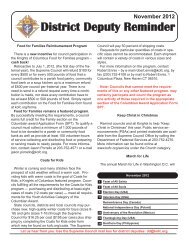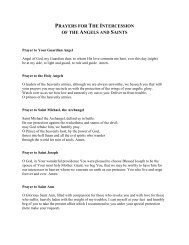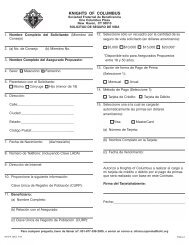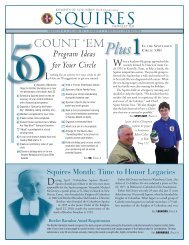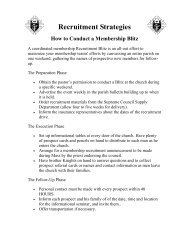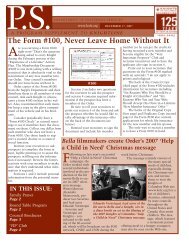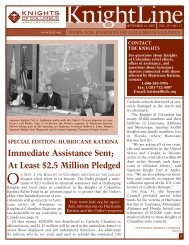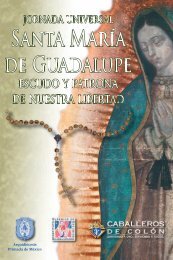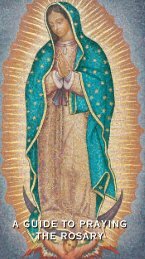CATHOLIC WORD BOOK - Knights of Columbus, Supreme Council
CATHOLIC WORD BOOK - Knights of Columbus, Supreme Council
CATHOLIC WORD BOOK - Knights of Columbus, Supreme Council
Create successful ePaper yourself
Turn your PDF publications into a flip-book with our unique Google optimized e-Paper software.
approval permits public devotion at the<br />
shrine and implies that at least one miracle<br />
has resulted from devotion at the shrine.<br />
Among the best known crowned shrines<br />
are those <strong>of</strong> the Virgin Mary at Lourdes<br />
and Fátima. Shrines with statues crowned<br />
by Pope John Paul in 1985 in South<br />
America were those <strong>of</strong> Our Lady <strong>of</strong><br />
Coromoto, patroness <strong>of</strong> Venezuela, in<br />
Caracas, and Our Lady <strong>of</strong> Carmen <strong>of</strong><br />
Paucartambo in Cuzco, Peru.<br />
Shroud <strong>of</strong> Turin: A strip <strong>of</strong> brownish linen<br />
cloth, 14 feet, three inches in length and<br />
three feet, seven inches in width, bearing<br />
the front and back imprint <strong>of</strong> a human<br />
body. A tradition dating from the 7th<br />
century, which has not been verified<br />
beyond doubt, claims that the shroud is<br />
the fine linen in which the body <strong>of</strong> Christ<br />
was wrapped for burial. The early history<br />
<strong>of</strong> the shroud is obscure. It was enshrined<br />
at Lirey, France, in 1354 and was<br />
transferred in 1578 to Turin, Italy, where<br />
it has been kept in the cathedral down to<br />
the present time. Scientific investigation,<br />
which began in 1898, seems to indicate<br />
that the markings on the shroud are those<br />
<strong>of</strong> a human body. The shroud, for the first<br />
time since 1933, was placed on public<br />
view from Aug. 27 to Oct. 8, 1978, and<br />
was seen by an estimated 3.3 million<br />
people. Scientists conducted intensive<br />
studies <strong>of</strong> it thereafter, finally determining<br />
that the material <strong>of</strong> the shroud dated from<br />
between 1260 and 1390. The shroud,<br />
which had been the possession <strong>of</strong> the<br />
House <strong>of</strong> Savoy, was willed to Pope John<br />
Paul II in 1983.<br />
Sick Calls: When a person is confined at<br />
home by illness or other cause and is<br />
unable to go to church for reception <strong>of</strong> the<br />
-64-<br />
sacraments, a parish priest should be<br />
informed and arrangements made for him<br />
to visit the person at home. Such<br />
visitations are common in pastoral<br />
practice, both for special needs and for<br />
providing persons with regular<br />
opportunities for receiving the sacraments.<br />
If a priest cannot make the visitation,<br />
arrangements can be made for a deacon or<br />
Eucharistic minister to bring Holy<br />
Communion to the homebound or<br />
bedridden person.<br />
Sign <strong>of</strong> the Cross: A sign, ceremonial<br />
gesture or movement in the form <strong>of</strong> a cross<br />
by which a person confesses faith in the<br />
Holy Trinity and Christ, and intercedes for<br />
the blessing <strong>of</strong> himself or herself, other<br />
persons and things. In Roman Rite<br />
practice, a person making the sign touches<br />
the fingers <strong>of</strong> the right hand to forehead,<br />
below the breast, left shoulder and right<br />
shoulder while saying: “In the name <strong>of</strong> the<br />
Father, and <strong>of</strong> the Son, and <strong>of</strong> the Holy Spirit.”<br />
The sign is also made with the thumb on<br />
the forehead, the lips, and the breast. For<br />
the blessing <strong>of</strong> persons and objects, a large<br />
sign <strong>of</strong> the cross is made by movement <strong>of</strong><br />
the right hand. In Eastern Rite practice,<br />
the sign is made with the thumb and first<br />
two fingers <strong>of</strong> the right hand joined<br />
together and touching the forehead, below<br />
the breast, the right shoulder and the left<br />
shoulder; the formula generally used is the<br />
doxology, “O Holy God, O Holy Strong One, O<br />
Immortal One.” The Eastern manner <strong>of</strong><br />
making the sign was general until the first<br />
half <strong>of</strong> the 13th century; by the 17th<br />
century, Western practice involved the<br />
whole right hand and the reversal <strong>of</strong><br />
direction from shoulder to shoulder.




